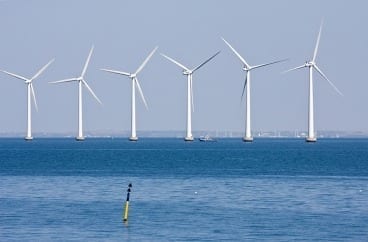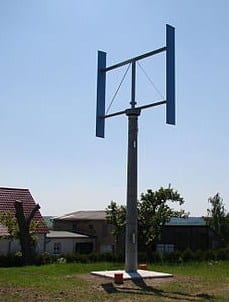
Innovative storage system could enable offshore wind farms to deliver power whenever it’s needed.
Offshore wind could provide abundant electricity — but as with solar energy, this power supply can be intermittent and unpredictable. But a new approach from researchers at MIT could mitigate that problem, allowing the electricity generated by floating wind farms to be stored and then used, on demand, whenever it’s needed.
The key to this concept is the placement of huge concrete spheres on the seafloor under the wind turbines. These structures, weighing thousands of tons apiece, could serve both as anchors to moor the floating turbines and as a means of storing the energy they produce.
Whenever the wind turbines produce more power than is needed, that power would be diverted to drive a pump attached to the underwater structure, pumping seawater from a 30-meter-diameter hollow sphere. (For comparison, the tank’s diameter is about that of MIT’s Great Dome, or of the dome atop the U.S. Capitol.) Later, when power is needed, water would be allowed to flow back into the sphere through a turbine attached to a generator, and the resulting electricity sent back to shore.
One such 25-meter sphere in 400-meter-deep water could store up to 6 megawatt-hours of power, the MIT researchers have calculated; that means that 1,000 such spheres could supply as much power as a nuclear plant for several hours — enough to make them a reliable source of power. The 1,000 wind turbines that the spheres could anchor could, on average, replace a conventional on-shore coal or nuclear plant. What’s more, unlike nuclear or coal-fired plants, which take hours to ramp up, this energy source could be made available within minutes, and then taken offline just as quickly.
The system would be grid-connected, so the spheres could also be used to store energy from other sources, including solar arrays on shore, or from base-load power plants, which operate most efficiently at steady levels. This could potentially reduce reliance on peak-power plants, which typically operate less efficiently.
The concept is detailed in a paper published in IEEE Transactions and co-authored by Alexander Slocum, the Pappalardo Professor of Mechanical Engineering at MIT; Brian Hodder, a researcher at the MIT Energy Initiative; and three MIT alumni and a former high school student who worked on the project.
The weight of the concrete in the spheres’ 3-meter-thick walls would be sufficient to keep the structures on the seafloor even when empty, they say. The spheres could be cast on land and then towed out to sea on a specially built barge. (No existing vessel has the capacity to deploy such a large load.)
Preliminary estimates indicate that one such sphere could be built and deployed at a cost of about $12 million, Hodder says, with costs gradually coming down with experience. This could yield an estimated storage cost of about 6 cents per kilowatt-hour — a level considered viable by the utility industry. Hundreds of spheres could be deployed as part of a far-offshore installation of hundreds of floating wind turbines, the researchers say.
The Latest Bing News on:
Innovative energy storage system
- Gold Recognition for AIDA Cruises for Innovative Lithium-Ion Battery Energy Storage Systemon May 26, 2024 at 10:16 pm
AIDA Cruises, the leader in the German cruise industry, was honored with the prestigious ESG Shipping Award International 2024 last Monday, May 20, in Athens/Greece.
- REPEAT - Metasphere Labs Announces Development of Innovative Carbon Credit Protocol for Grid-Scale Batterieson May 26, 2024 at 9:30 pm
By aggregating multiple battery storage systems and optimizing their collective ... is actively engaging with key stakeholders across the energy and technology sectors to develop and implement this ...
- Hyxipower showcases innovative small commercial solutions and energy storage systemson May 22, 2024 at 4:26 pm
Hyxipower, a leading provider of smart energy solutions, recently unveiled its innovative small commercial solutions and advanced energy storage system products at Solar and Storage Live Australia ...
- DOE Awards $15M to Accelerate Commercialization of Advanced Energy Storage Technologieson May 15, 2024 at 3:45 pm
These projects aim to demonstrate the reliability and cost-effectiveness of innovative energy storage solutions, which are crucial for the future of clean, efficient, and resilient energy systems.
- Anker SOLIX X1 offers effective solar power storage for your home backupon May 1, 2024 at 11:24 am
This is made possible by the X1’s relatively slim design at 5.9 inches thin, which Anker SOLIX claims is 40% thinner than traditional home energy storage systems. Thanks to the Innovative Energy ...
- Green Energy Expo 2024: Sungrow Unveils its Innovative Solar-Plus-Storage Solutions to Facilitate South Korea's Energy Transitionon April 26, 2024 at 3:39 am
As the latest addition to Sungrow's liquid-cooled energy storage system line, PowerTitan2.0 goes beyond traditional all-in-one solutions. It seamlessly integrates an innovative AC storage design ...
- Sungrow Will Premiere Its Innovative Energy Storage System at the WFES Abu Dhabi 2024 Soonon April 3, 2024 at 3:57 am
It seamlessly integrates an innovative AC storage design, embedded PCS, standard 20-foot 5MWh full liquid cooling, and a robust 10MWh battery energy storage system. Throughout its lifespan ...
- Century-old tech company transforms traditional energy storage system with innovative modular method — here's how it workson March 30, 2024 at 5:21 am
PV Magazine explained that Socomec, a French industrial group, created a modular energy storage system that can hold up to 1,116 kilowatt-hours (kWh). The system, dubbed Sunsys HES L Skids ...
- EV automaker unveils innovative new battery energy storage system: ‘More energy extracted, longer lifetime’on October 31, 2023 at 2:10 pm
Croatian electric vehicle maker Rimac announced in September that it is entering the storage sector with its highly touted SineStack system, according to a report from Energy Storage News (ESN).
The Latest Google Headlines on:
Innovative energy storage system
[google_news title=”” keyword=”innovative energy storage system” num_posts=”10″ blurb_length=”0″ show_thumb=”left”]
The Latest Bing News on:
Energy storage
- Energy storage fire near Otay Mesa continues to improveon May 26, 2024 at 10:03 pm
SAN DIEGO — Firefighting efforts continue to improve containment of a commercial structure fire that broke out 11 days ago at an energy storage facility in the Otay Mesa area as property managers and ...
- Scientists explore mushrooms as potential solution for problems with global energy storage applications — here's how it could revolutionize clean energyon May 26, 2024 at 9:00 pm
How's that for turning mushrooms into a planet-saving superpower? Scientists explore mushrooms as potential solution for problems with global energy storage applications — here's how it could ...
- Crews Still Engaged at Energy Storage Fire Near Otay Mesa After 10 Dayson May 26, 2024 at 5:38 am
Firefighting efforts continue to improve containment of a commercial structure fire that broke out 10 days ago at an energy storage facility in the Otay Mesa area, officials said Saturday.
- Intersolar & Energy Storage North America opens registration for new Texas conferenceon May 24, 2024 at 5:04 am
Intersolar & Energy Storage North America (IESNA) announced registration is now open for its new regional event slated for November 19 to 20, 2024, at ...
- Recurrent Energy secures €674 million financing for solar and storage projectson May 24, 2024 at 4:46 am
Recurrent Energy has secured a €674 million revolving credit facility to expand its European solar and BESS portfolio.
- Scientists believe accident with battery-like supercapacitors allows for greater energy storage: 'It could be a turning point'on May 24, 2024 at 3:45 am
"Their durability and extremely fast charging capabilities make them useful for a wide range of applications." Scientists believe accident with battery-like supercapacitors allows for greater energy ...
- NextEra Energy, PNM commission 240MW solar, battery storage projecton May 23, 2024 at 1:05 pm
NextEra Energy Resources, a subsidiary of Juno Beach, Florida-based NextEra Energy Inc. (NYSE: NEE), and the Public Service Co. of New Mexico, on Thursday officially commissioned a new ...
- EV maker Tesla breaks ground on Megapack energy storage battery factory in Shanghaion May 23, 2024 at 4:18 am
Chinese state media have reported that electric vehicle maker Tesla has begun construction of a factory in Shanghai to make its Megapack energy storage batteries ...
- Solar & Storage Live Philippines 2024: Sungrow's Solar-Plus-Storage Solutions Facilitating the Philippines' Energy Transitionon May 23, 2024 at 2:06 am
The Rapid Shutdow (SR20D-M) holds the patented FHC bypass technology, that decreases loss and avoids overheating. It can shutdown rapidly in only 20s and prevent risk with 10s pre-protection. SR20D-M ...
- BEYOND EXPO 2024 | CATL CEO’s vision takes shape with AI, energy storage, and moreon May 22, 2024 at 6:34 pm
As emerging technologies, from artificial intelligence to renewable energy, show potential to tackle global challenges, they are also shaping the vision ...
The Latest Google Headlines on:
Energy storage
[google_news title=”” keyword=”energy storage” num_posts=”10″ blurb_length=”0″ show_thumb=”left”]










